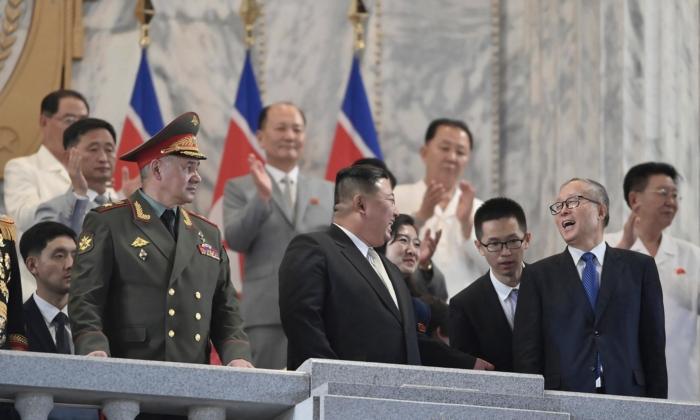Commentary
The recent discovery that the Chinese regime is responsible for the
U.S. fentanyl crisis stands as a clear illustration of the asymmetric warfare being waged on the United States by the Chinese Communist Party (CCP) and its expanding bloc of allies.
Asymmetric warfare entails using
unconventional weapons, proxy warfare, guerrilla tactics, terrorism, civilian shields, information warfare, disinformation campaigns, and cyberwarfare to challenge and disrupt adversaries.
Along with asymmetric warfare, another tool in the CCP’s Great Power competition directed at the United States is its
coalition building. Since the start of the Russo–Ukrainian War, the relationship between
Beijing and Moscow has been intensifying. Beijing has been
supporting Russia economically and providing dual-use and military equipment.
The CCP and its allies excel in asymmetric warfare, each possessing a distinct set of skills. China’s economic leverage and
cyberwarfare prowess can potentially disrupt U.S. markets and infrastructure. Russia’s mastery of
disinformation campaigns is fostering discord among the U.S. population. Meanwhile, Iran and North Korea’s missile capabilities pose a persistent threat, necessitating the diversion of U.S. resources. These tactics are designed to inflict substantial harm without resorting to direct military conflict, presenting a challenge that the United States may find difficult to counter, given its traditional dominance in conventional warfare.
Concrete examples of asymmetric warfare include Iran and Russia’s support of proxy armies in Syria,
Iraq, Yemen,
and Africa. Groups like Hamas, Hezbollah, and the Houthis employ guerrilla tactics and terrorism while
using civilian shields. Additionally, Russia and the Chinese regime have been actively engaged in information warfare, conducting online disinformation campaigns to sway public opinion in favor of Moscow’s attack on Ukraine and to garner
support for Hamas in the Israel–Gaza war. Furthermore, all major axis members have launched and continue to carry out
increasingly sophisticated cyberattacks against the United States.
The CCP supports Iran, a key
oil supplier to China, while Beijing is believed to be supplying Tehran with
weapons technology. In turn, Iran backs its proxy,
the Houthis, who disrupt maritime transportation logistics by targeting merchant ships in the Red Sea, posing challenges for the United States and its allies. The Houthis have
made a pact not to target Russian or Chinese vessels.
The war is already underway, regardless of whether or not Washington has formally acknowledged it. However, it is not yet lost, and the CCP-led bloc is far less unified than the U.S.-led bloc. U.S. allies, including prominent groups like NATO and the European Union, along with close partners like the United Kingdom, Australia, and Canada, share deep historical ties. They also have similar languages, cultures, and a common Christian heritage. Additionally, allies such as Israel, Taiwan, South Korea, Japan, and the Philippines have longstanding relationships with the United States, often relying on U.S. protection from larger aggressors, particularly China in recent times.
The overarching objective of the U.S.-led bloc is to uphold the international rules-based order, essentially aiming to sustain the existing system and, if feasible, to expand its reach to developing nations and those in the process of transitioning to democracy.
Several autocratic nations are among the CCP’s allies. By their very nature, autocratic regimes are typically less inclined to cooperate and find common ground than democratic states. While China and North Korea share certain similarities, Russia and Iran have limited commonalities with China. None of these four countries share a common language, and their leaders do not share identical objectives.
Xi Jinping seeks to reshape the
international order in line with his vision, advocating for China’s leadership role. Meanwhile, Vladimir Putin aims to consolidate his power within his domain, likely aspiring to expand it by reabsorbing territories once part of the
old Russian Empire. North Korea, on the other hand, harbors ambitions of invading South Korea. While the CCP may lean toward preferring a unified Korean peninsula under Pyongyang’s rule, it’s also plausible that this scenario is the last thing Xi wants. Beijing’s support for sanctions on Pyongyang’s nuclear weapons program underscores its desire to prevent a
nuclear-armed and powerful North Korea on its border. Therefore, Kim Jong Un’s objectives appear to directly conflict with those of Xi.
Finally, Iran, a Muslim theocracy, seeks to propagate
its Islamic revolution throughout the Middle East. However, considering that both China and Russia have brutally repressed their own Muslim populations, with
Uyghurs in Xinjiang and
Wahhabis in Chechnya, it seems improbable that Xi or Putin would be willing to go to war to fulfill Ayatollah Khomeini’s ambitions.
The cohesion of the CCP-led bloc could falter in the event of a war, especially if it involves the United States and any actor other than China or Russia. China’s sole
mutual defense agreement is with North Korea, and the CCP typically restrains Pyongyang from instigating conflicts with South Korea and Japan, which could draw the United States into the fray. Russia, occupied with its activities in Ukraine, risks provoking NATO involvement if it were to move into Poland. And while this may not bode well for Moscow, a conflict tying up the United States with Russia would present strategic opportunities for Tehran and Beijing to advance their respective objectives.
Whether the conflict escalates into a full-blown military confrontation is uncertain at this point. However, one thing is clear: The CCP-led bloc will persist in their asymmetric warfare, disinformation campaigns, proxy wars, and overall harassment, aiming to diminish U.S. influence without provoking a direct war.
Views expressed in this article are opinions of the author and do not necessarily reflect the views of The Epoch Times.







